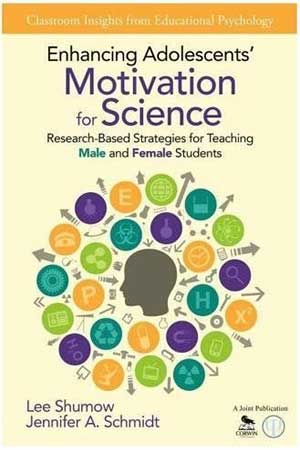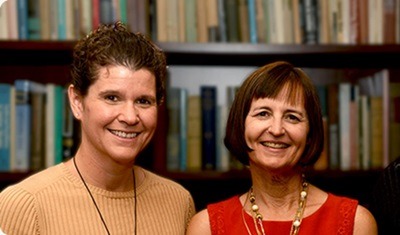Oh, if science teachers only knew what their students were really thinking about during lessons.
Well, Northern Illinois University researchers actually figured out a way to tap into high school students’ thoughts during class time, and there were plenty of surprises and valuable insights.
So many, in fact, that the three-year research project studying students’ motivation to learn science has resulted in a new book that has the educational community buzzing.
Penned by Lee Shumow and Jennifer Schmidt, both professors in NIU’s Department of Leadership, Educational Psychology and Foundations, the book is aptly titled “Enhancing Adolescents’ Motivation for Science.” It provides a collection of research-proven strategies on how to motivate students and is accompanied by an information- and video-packed companion website.
The book has received rave reviews, and although just recently published, it’s fast becoming a go-to guide for science teachers.
“As I read the book, I began to revisit the traits of what a ‘master teacher’ should be and the pedagogical principles upon which this is based,” said Mike Mieszala, an environmental science teacher at Warren Township High School in Gurnee. “It was a great chance to take a step back, reflect and assess my teaching.”
A national priority
Producing more college graduates in the areas of science, technology, engineering and mathematics (STEM) is national priority. Despite huge demand and large-scale predicted job growth in STEM fields, only 16 percent of American high school seniors are proficient in mathematics and interested in a STEM career.
Against this backdrop, the National Science Foundation (NSF) provided about $1.5 million in funding for the NIU professors’ initial study into student motivation, related research, the new book project and assistance with book distribution. About 2,500 books are being distributed free of charge.
Authors Schmidt and Shumow are on the teaching circuit, speaking at educational conferences nationwide and leading in-depth professional development sessions for area school teachers (including at a Friday, Feb. 7, conference at NIU).
“During our research, we heard from many teachers who thought of motivation as a trait, not a state,” Schmidt said. “In fact, teachers can do a lot to impact how excited students are about science, but they need to be armed with motivational strategies.”
Among some of the authors’ quick suggestions to educators:
- Survey students and even their parents to identify student interests, and tie those interests to science lessons to make them more meaningful.
- Regularly highlight the relevance and utility of science in daily life.
- It’s more important to challenge students rather than to give them easier lessons where success is assured. Challenged students are more engaged.
- Don’t tell students, “You’re so smart.” Research shows that such praise can inadvertently discourage students when they struggle and lead them to conclusions such as, “I’m just not a science person.” It’s better to encourage students to embrace the values of hard work and persistence when encountering a challenge.
Mining the thoughts of students
 The research project leading to the new book was known as Science-in-the-Moment (SciMo). Led by Schmidt, the team included senior researcher Shumow, other NIU professors, outside advisers and about dozen NIU graduate students. They studied 244 high school students and 13 science teachers at one school during the 2008-09 academic year.
The research project leading to the new book was known as Science-in-the-Moment (SciMo). Led by Schmidt, the team included senior researcher Shumow, other NIU professors, outside advisers and about dozen NIU graduate students. They studied 244 high school students and 13 science teachers at one school during the 2008-09 academic year.
The research team members videotaped 100 hours of classroom lessons and dissected “every utterance from the teachers’ mouths.”
They mined the thought processes of students by arming them with beepers that would go off at random intervals during classroom instruction. Once alerted, students completed a checklist gauging their concentration, feelings about the lesson and motivation to learn.
“Our methodology gave us access to what was going on in students’ heads,” Shumow said.
“Interestingly, students sometimes said they were having fun and enjoying themselves but also indicated they weren’t learning anything and the lessons were not important to them. So teachers were misled into believing students were into it. We also were able to observe a lot of missed opportunities to pique the students’ motivation.”
Science and gender
The researchers also discovered interesting gender differences.
 For instance, the study found that science teachers spend 39 percent more class time directly addressing boys. Compounding the problem is that girls already are bored, disengaged and stressed in science classes when compared to boys.
For instance, the study found that science teachers spend 39 percent more class time directly addressing boys. Compounding the problem is that girls already are bored, disengaged and stressed in science classes when compared to boys.
Consequently, while girls perform academically on a par with boys, they still feel less competent than they actually are.
“Girls’ motivation in science is a lot more fragile,” Schmidt said. “Teachers need to do more to convince female students of their ability and also to provide them with more role models in science.”
Eighty-eight inspirational videos
After the research was completed in 2011, Schmidt and Shumow embarked on the Empowering Teachers to Enhance Adolescents’ Motivation for Science (E-TEAMS) project, which produced the new book and companion website.
“There was no other book geared specifically for science teachers of adolescents on how to motivate,” Shumow said. “We learned a lot of things from our Science-in-the-Moment study that we realized teachers needed to know.”
Chock-full of information and lessons that complement the book, the website includes 88 brief video vignettes that demonstrate best practices or feature interviews with award-winning high school science teachers and with practicing scientists.
Those working scientists talk about the influence of high school teachers and parents on their career choices. They can serve as role models for students, particularly for adolescent girls who hear the stories of successful women in science-related fields.
“We hope to have an impact on the way teachers teach science so that it will be more engaging for students,” Schmidt said. “And we hope to help teachers understand they can have a big impact on student motivation.”
Related:


